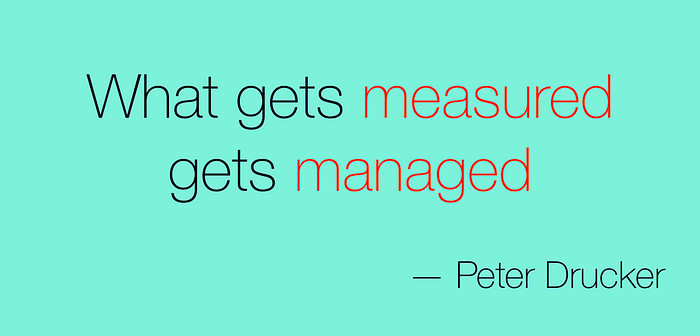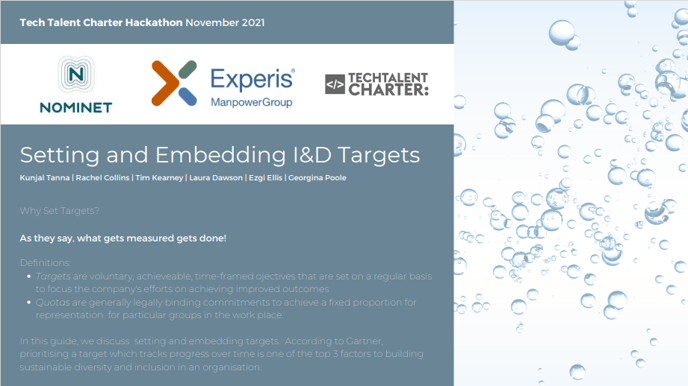Create clear and explicit accountability measures and structures to ensure D&I is properly prioritised. Without accountability and appropriate review mechanisms, organisations are unlikely to make meaningful and sustained progress on D&I.
Employer recommendations

Setting targets
What’s so powerful about setting goals?
Iris Bohnet and Siri Chilazi, in their article, Behavioral Economics: Promoting Diversity, Equity, and Inclusion Through Goal-Setting published in The Behavioral Economics Guide 2021 shared that goals: create accountability: the expectation that you’ll have to justify your actions; build recognition: accomplishing a goal creates pride and recognition; convey social norms: goals tell us what’s the (socially) acceptable thing to do; and activate competition: compare your progress against others.
➖The Behavioural Insights Team provide 5 steps to set effective targets:
- Set clear, specific targets for named individuals to deliver;
- Set deadlines for their achievement;
- Make targets challenging but realistic;
- Publish and share targets;
- Monitor progress.
TTC have created an open source Google sheet listing publicly available diversity representation targets for a number of organisations (includes Signatories and non Signatories).
Assign accountability among leaders at all levels
➖Report regularly (e.g. quarterly) on D&I metrics and agreed goals.
Report by individual leaders and the area of the organisation which they represent. According to recommendations in this HBR article by Lee Jourdan, the metrics most useful for assessing D&I progress are:
- Attrition (voluntary and involuntary) - are you disproportionately losing/letting go people from underrepresented groups? Also look at exit survey data for themes by group.
- Performance - is there equal distribution of high and low ratings across all groups?
- Promotions - assessed by pay grade, race, and gender, and again assessed for balance between different demographic groups.
- Leadership pipeline - the leadership pipeline should reflect the representation of the workforce at a minimum.
- Employment pipeline - percentage of underrepresented groups who apply, interview, are offered, and then accept. Is percentage the same regardless of race and gender?
- Pay equity - “Pay equity” and “pay gap” are two different analyses. Pay equity exists when employees are receiving the same pay for the same work regardless of how individuals identify. Pay gap is the delta in average compensation between two groups regardless of the types of jobs that make up that average.
- Inclusion - ideally measure both how inclusion varies amongst different identities and the inclusive behaviors of senior leaders and managers.
➖Use competition.
Drive competition between leaders by showing data compared to goal/benchmark for several leaders within the same report. Some organisations publish league tables comparing results on demographics across different areas. Invite nominations for an ‘inclusive leader’ competition to showcase people at team leader level who are demonstrating the characteristics of an inclusive leader.
➖Require leaders to include measurable D&I inputs and outputs in their personal (‘bonusable’) objectives to link compensation to D&I.
According to a report by The Conference Board, a vast majority of S&P 500 companies are now tying executive compensation to some form of ESG performance—growing from 66 percent in 2020 to 73 percent in 2021. The most significant increase was found in companies’ use of diversity, equity & inclusion (DEI) goals, rising from 35 percent in 2020 to 51 percent in 2021, as investors and other stakeholders continue to focus on diversity—making it a priority for companies as well. Tying diversity to executive compensation is not a silver bullet but it sends a message about accountability.
'In our partner income allocation process, we have recognised and rewarded those partners who have made a positive contribution to the delivery of our diversity targets', PWC UK.
➖Generate informal accountability
Do this by simply asking about progress in regular conversations, by regularly reporting numbers (hiring, attrition, promotions, inclusion scores) and asking about their plan to correct. Encourage leaders to ask each other.
➖Evaluate leader buy-in of accountability measures.
Gartner recommends assessment of the following:
- Leaders understand (and trust) the metrics used to monitor and evaluate progress.
- Leaders feel they have the resources and ownership necessary to affect relevant D&I outcomes.
- Leaders recognize and can articulate why improving D&I outcomes is a business imperative.
- Leaders view themselves as D&I champions and are invested in making progress on outcomes.
- Leaders model inclusion in how they engage employees in their day-to-day work.
➖Accountability doesn’t have to be just top-down: senior peers can also hold each other accountable. Mark Lomas, Head of Culture at Lloyd's of London, shared that their Senior Leadership Team have a shared 'group scorecard' that drives more than half of a leader's performance evaluation and 15% of the scorecard is weighted to Culture. The impact of this shared scorecard is that the leaders hold each other to account. Listen to the recorded session from d&i Leaders when this example was shared: What’s next for inclusive leadership?
➖Ask senior leaders whose areas are further behind, to join a diversity board/task force, in order to raise visibility and focus action on DEI.
➖Devolve accountability broadly and deeply in the organisation. Make inclusion goals part of the performance objectives of leaders at all levels, not just one or two senior executives. Everyone has to know what the goals are for D&I and feel ownership for reaching them.
➖Connect inclusion goals with the core purpose, strategy and values of the organisation. Being clear about how inclusion can help drive business results is key. Having inclusion as one of the corporate values makes it easier to make it part of the ongoing conversation in the organisation and to raise people’s expectations around actions they will take.
Governance
- Provide strategic guidance and cross-function insight to D&I functional strategy by aligning D&I strategy to the overall business strategy
-
Drive individual leader accountability by contextualising organisational D&I strategies.
-
Achieve employee buy-in and satisfaction by communicating with employees and ERGs about the presence and achievements of the executive D&I council, increasing its effectiveness.
➖ An executive D&I council should hold Executive Directors accountable against targets with timely and granular management information, which is linked to their reward.
➖ An executive D&I council should ensure managers are held accountable by leadership against expectations and be linked to their performance rating.
➖During a TTC Hackathon, subject matter experts came together to hack the topic 'Setting and embedding inclusion and diversity targets'. This team's product is here.'If you’re a board member, you have an essential role to play in D&I governance. You should make sure there is action and change that employees can see and feel. You should be asking your CEO questions about:
- The current experience and representation of non-white groups.
- Their leadership on the D&I strategy and goals.
- Their visibility to employees and the community regarding these matters.
- The progress the company is making on D&I goals'. 5 Strategies to Infuse D&I into Your Organization, HBR

💡'Every three months, the leadership and management population sit down and look at our diversity data straight in the face. We ask ourselves, what’s changed and why?, what hasn’t changed and why?, and we hold ourselves accountable to actions that will help us achieve our aspiring EDIB vision, that by FY29, Coeo’s population will mirror the representation of the Talent Tech Charter in the gender and ethnicity spaces in tech-specific roles', Paula McDevitt, Support Practice Team Lead at Coeo, shared in Signatory guest blog: Embracing Equity at Coeo.
'My view is and always has been, that positive action initiatives should be to support people getting into the system whether that be the recruitment process or promotion process. We should set targets like 50% of our executive promotion process entries will be women, not 50% of our new executives will be women. Don’t get me wrong, we need the later targets/ ambitions as well, however it is important that they are aspirations rather than a positive action outcome. Positive action targets should be set around “entry into a process” and not at the outcome stage. As I always say: Bring us to the start line and we can run the race ourselves! (given a fair and equal opportunity)', Asif Sadiq MBE in Why I don't believe in the Robin Hood style of Diversity!
Further information
- Guide: How to set effective targets, The Behavioural Insights Team
- Guide: Linking Executive Compensation to ESG Performance, The Conference Board
- Article: 7 Metrics to Measure Your Organization’s DEI Progress, HBR
- Guide: The Behavioral Economics Guide 2021
- Video: TTC Signatory Forum: Incentivising D&I goals
- Article: How helpful are targets and quotas in DE&I?, d&i Leaders
- Video: Showcasing DE&I performance to the C-suite, d&i Leaders
- Article: Drive Accountability by Requiring DEI Progress for Leader Advancement, Gartner (paid subscription required)
- Article: DEI Initiatives Are Futile Without Accountability, HBR
- Advance Your DEI Strategy With Baker Tilly’s Article: Chief Diversity Officer Shane Lloyd, Gartner (paid subscription required)
- Toolkit: Establishing Leader Accountability for DEI Objectives, Gartner (paid subscription
- Report: What Really Works: Ensuring Inclusive Working Cultures, BITC
- Article: 5 Strategies to Infuse D&I into Your Organization, HBR
